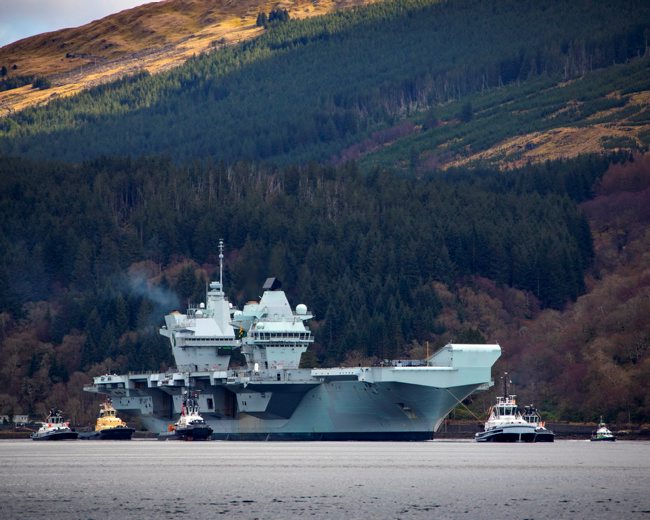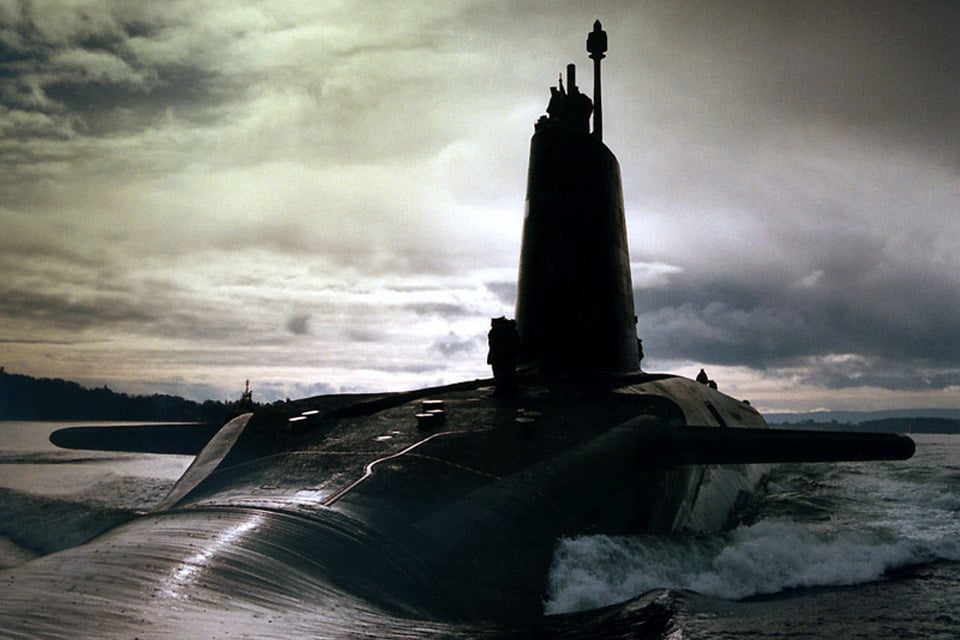
WASHINGTON, D.C. – The U.K. plans to have a greater British presence in the Indo-Pacific region, as it adheres to a recent security assessment that calls for a pivot to Asia, the top admiral in the Royal Navy said on Wednesday.
While the United States has for several years emphasized a strategy concentrating on the Indo-Pacific and a military threat from China, the U.K. in March released a strategy document that calls for its own shift to the region and specifically names China as a competitor.
“I think we’ve been very clear in our integrated review that through a security lens, we see Russia as being a distinct threat and we see China as being a challenge and a competitor,” First Sea Lord Adm. Tony Radakin told reporters today at the U.S. Navy Museum.
“And I think when we talk about a tilt to the Indo-Pacific, it’s about recognizing the economic weight of the Indo-Pacific. By 2040 to 2050, 40 percent of the world’s GDP is going to be harbored in that region. So we’re an outward-facing maritime trading nation that has interests all around the globe. And therefore we’re reaching out and following those interests. And that to me – it’s incredibly normal. It’s part of our nation’s history and trading traditions. And that’s what’s happening with the Indo-Pacific.”
Radakin is in Washington, D.C., ahead of U.K. Royal Navy aircraft carrier HMS Queen Elizabeth‘s (R08) maiden deployment, which will mark a growing British presence in the region.

“Absolutely there will be an increased naval presence in the Indo-Pacific, but we will continue to be strong in the Euro-Atlantic. We’ll continue with our responsibilities in the Falklands, in the Mediterranean, in the Caribbean, and in the Gulf. But as our integrated review said, the U.K. is tilting further to the Indo-Pacific,” Radakin told reporters.
“And that straddles the whole of defense, and for the [U.K.] Navy that means at the western end of the Indian Ocean, we’re looking to have a littoral ready group, so our war marines, operating at that end of the Indian Ocean so that we can strengthen our partnership with India,” he continued. “We reach out to our Gulf nations. We use our territory in the middle of the Indian ocean – the British Indian ocean territories in Diego Garcia – and reach down to east Africa. But then we’re also reaching further east and we’re building on the relationships that we already have.”
The U.K.’s review not only stressed the significance of the Indo-Pacific, but also used 2030 as a time horizon, like the U.S. Marine Corps has done with its force design initiative.
“Increasing great power competition is unlikely to mean a return to Cold War-style blocs. Instead, the influence of middle powers is likely to grow in the 2020s, particularly when they act together,” the review reads. “In this context, the Indo-Pacific will be of increasing geopolitical and economic importance, with multiple regional powers with significant weight and influence, both alone and together. Competition will play out there in regional militarisation, maritime tensions, and a contest over the rules and norms linked to trade and technology.”
Queen Elizabeth‘s first deployment will include a mixed air wing of U.S. and U.K. Marine F-35Bs and a multi-national carrier strike group that will head to the Indo-Pacific.
The “Wake Island Avengers” of U.S. Marine Fighter Attack Squadron (VMFA) 211 and the Royal Air Force’s 617 Squadron “The Dambusters” aboard the carrier will make up the largest F-35 deployment to date.
“We’re going to learn a lot about how we use that fifth-generation capability in ways that perhaps we haven’t even though of yet. Every time we have a pilot that does a sortie in one of those aircraft, they come back with more insights in terms of how we can use them with fourth-gen, as an example, how we can use them with allies and partners,” said Chief of Naval Operations Adm. Mike Gilday.
“And so I think that there’s an interoperability piece to that for sure, but also I think an interchangeability piece in the future, with respect to how . . . aircraft from both navies and the Marine Corps work together.”
Both the U.S. and the U.K. have emphasized interoperability and interchangeability between their militaries leading up to the deployment of Queen Elizabeth’s multi-national carrier strike group, which includes Dutch frigate HNLMS Evertsen (F805) and U.S. Navy destroyer USS The Sullivans (DDG-68).

“We use the phrase interoperability, so that we, we’ve got shared communication systems. We can share information around the battlespace. We can use each other’s operational units. When we talk about interchangeability, it’s at another level again,” Radakin said. “And it’s not just with jets and carriers and escort ships, it’s our nuclear submarines as well – that we have shared missions in the North Atlantic, where it could be a U.S. Navy submarine, it could be a Royal Navy submarine.”
The partnership between the U.S. and U.K. extends to the U.S. Coast Guard. While the Coast Guard already works with the Brits in the Caribbean on counter-drug operations, the service also recently operated with the U.K. in the Arctic, where U.S. officials have concerns over both Russian and Chinese activity.
“We were recently in the Arctic with our Polar Star. We had two U.K. Royal Navy sailors from the HMS Protector (A173) onboard, so we share interest in the high latitudes, the polar regions,” U.S. Coast Guard Commandant Adm. Karl Schultz told reporters. “And we have an exchange program – engineering exchange program. We have some Coast Guard engineers serving in the fleet, they’re going to be part of the carrier strike group.”
Soon the Coast Guard will restart an aviation exchange with the Brits, Schultz said.
“We had that for many years and then when the Royal Navy got out of the search and rescue business that kind of withered in 2016,” Schultz said. “But we’re bringing it back and we’ll use airborne use of force for law enforcement missions – we’re going to sign that next week I believe here in Washington.”
Gilday said the U.S. Navy has recently been sailing in the Arctic region more frequently and that it often does so with the U.K., the Coast Guard and the Marine Corps.
“It’s not uncommon to have a British ship escort a U.S.-flagged vessel through the Strait of Hormuz or the Bab el-Mandeb. And so, we do that for each other quite often. In the Indo-Pacific, our relationship with allies and partners – we’re sailing and steaming together every single day. So there’s not a week that goes by where we’re not doing a half a dozen exercises or operations with allies and partners.”





